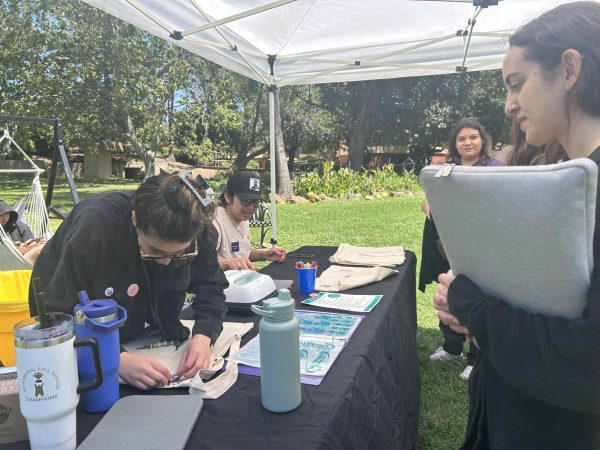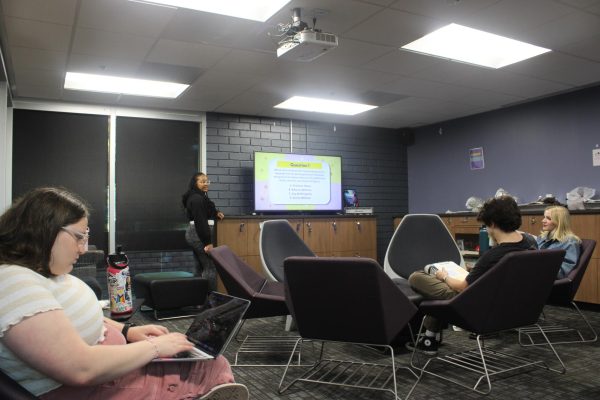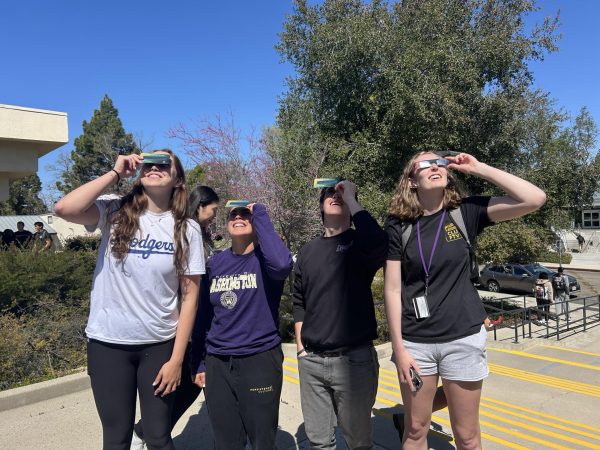Largest NSF Grant applied toward Stone’s squirrel monkey research
Photo Contributed by Anita Stone
Assistant Professor of Biology Anita Stone received the largest National Science Foundation grant Cal Lutheran has ever been given to continue her research on the squirrel monkeys in the Amazon Rainforest.
April 5, 2022
The National Science Foundation provided California Lutheran University with a grant of $307,486, the largest grant the institution has received. This will aid Assistant Professor of Biology Anita Stone’s research of squirrel monkeys in the eastern Amazonian forest.
Stone and 12 undergraduate students will study the sexual selection of Brazilian squirrel monkeys over the next four summers, beginning in the summer of 2023. She is currently looking to recruit students for the research in Brazil. Their entire trip will be paid for, and they will receive a salary for assisting Stone study the squirrel monkeys.
“The whole project has been designed to involve undergraduate students. I go with students every summer, but this grant will enable me to take more students than I usually do. I think it’s going to be really impactful because for working with primates in the wild, there are almost no opportunities in the U.S. for undergrads to do that,” Stone said.
In an email interview, Claire Meuter, a previous research student who spent the summer of 2019 with Stone in Brazil, said she could not speak highly enough of the experience. She said it inspired her to work on obtaining a master’s degree and that the experience was what gave her the confidence to take the next step.
“Beyond being a really cool project, I got to be fully immersed in the culture of the village and became close with the family that hosts Dr. Stone every year. Before this project, I was missing a lot of direction on what to do after undergraduate, and Dr. Stone was able to really inspire me to continue my education,” Meuter said.
In regard to her research, Stone said squirrel monkeys are seasonal breeders and during mating season, only the males broaden and fatten. She said they believe this is a kind of sexual selection, meaning the males could be widening to impress the females. Stone said they are proposing whether the females prefer to mate with the more fattened males or if fattening helps males compete with the other males.
She also is looking to see through DNA samples if the more fattened males have higher reproductive success. She said the final step is to understand the reason why the females may be selecting the more fattened males. One of her hypotheses is that the more fattened males have better genes.
Stone said there are multiple examples of male traits becoming exaggerated in the animal kingdom, and she said the fact that the male squirrel monkeys only fatten during mating season strongly indicates that it has to do with sexual selection. She said research on sexual selection for primates typically focuses on male competition, but female choice has not been explored as much. Stone said her study challenges that bias in the field.
Running the paternity tests will be Jessica Lynch, Ph.D. associate professor and vice chair of academic personnel and development at The University of California, Los Angeles Institute for Society and Genetics. Janet Buckner, Ph.D. assistant professor at the University of Texas at Arlington, will study the blood and tissue samples with graduate students in her lab.
Stone also said there are several challenges that make it difficult to study squirrel monkeys in their habitat, and few people study them in the wild for these reasons.
“They weigh no more than two pounds, their groups are super large, and they are super active. They are like five-year-olds on caffeine. They also travel long distances and are hard to tell apart from each other, so they’re really hard to keep track of,” Stone said.
In addition to being inspired by Jane Goodall, she said her Ph.D. advisor, Paul Garber, taught her various important lessons.
“One of the things he always said was that, with primates, it’s usually not what you think it is. He also said that because primates are so smart, you need plan A, plan B, plan C… . You need backup plans. He’s really influenced the way I think about primate behavior,” Stone said.
Stone said she knew she wanted to study animal behavior but did not know she wanted to study primates until she took a field course as an undergraduate in Costa Rica. She has now been studying the same population of squirrel monkeys since 2000 and has been to the Amazon at least 20 times.
“The experience of being in the forest and being with the animals is amazing. My fieldsite is privately-owned land that is protected by residents of the local community that live there. When I’m there with the students, there’s a lot of community interaction and community outreach,” Stone said.
Seta Aghababian was another previous research student who spent the summer of 2019 in Brazil with Stone. She said being a part of Stone’s lab and working in Brazil was the most significant contributing factor to her decision on a career in ecology.
“I had always known that I wanted to do something in science, but until researching in Brazil, I hadn’t really had any opportunities in science that made me super passionate about one field. I think it was just so special getting to be in Brazil, following wild monkeys in their natural habitat and getting to go through the trials and tribulations of fieldwork. After that, I was dead set on continuing to research animal behavior, and I also wanted to apply that to conservation,” Aghababian said.
Both Aghababian and Meuter said Stone’s research is unique in the way it focuses on a rarely studied aspect and because it may lead to similar research on other species or animals.
“Dr. Stone’s study is so comprehensive, combining behavioral, physiological, and genetic information to determine the importance of female choice in mate selection and managing to do so in a wild setting where the animals can behave as naturally as possible. Studying this topic shines a brighter light on the importance of female mating behavior and will not only generate more interest to study this behavior in primates but likely in many other species as well,” Aghababian said.











